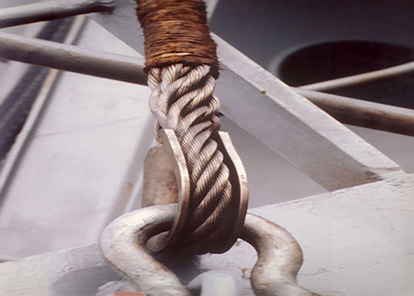HSC is a member of the Association of Wire Rope Fabricators (AWRF). We operate wire rope centers at our facilities specializing in slings, drill and sand line, mobile spooling and more.
Have us at your next safety meeting to discuss proper wire rope sling use, inspection and removal criteria, maintenance and training.
| According to ASME B30.9, you must remove a wire rope sling from service immediately if any of these following 8 conditions are present. |
|
|
1. Rated Capacity Tag
Missing or illegible sling identification tag.
|
|
|
2. Broken Wires
For single part body slings and strand laid grommets: 5 broken wires in one strand in one rope lay or 10 broken wires in all strands in one rope lay. For cable-laid, cable-laid grommets and multi-part slings, use the following guidelines.
|
|
ALLOWABLE BROKEN WIRES
Cable-laid grommet 20 per lay
Less than 8-part braid 20 per braid
8-part braid or more 40 per braid |
|
|
|
3. Metal Loss
Wear or scraping of one-third the original diameter of the outside individual wires.
|
|
|
4. Distortion
Such as kinking, crushing or birdcaging. Look closely for wires or strands that may have been pushed out of their original positions in the rope.
|
|
|
5. Heat Damage
Any metallic discoloration or loss of internal lubricant caused by heat exposure.
|
|
|
6. Damaged End Attachments
Cracked, bent or broken fittings, also, any evidence that eye splices have slipped.
|
|
|
7. Bent Hooks
No more than 15 percent over the normal throat openings (measured at the narrowest point) or twisting exceeding 10 degrees.
|
|
|
8. Metal Corrosion
Severe corrosion of the rope or end attachments that has caused pitting or binding of the wires. Light rusting doesn't normally affect a sling's strength.
|
|









